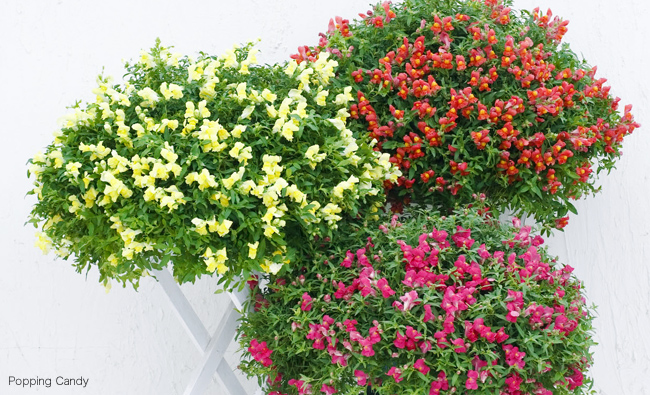- Top>
- Episode 19 Snapdragons

Episode 19 Antirrhinum
Breeding without Limits
Antirrhinum are plants from the Scrophulariaceae Antirrhinum genus. They originate from Mediterranean Southern Europe and North Africa and are said to have arrived in Japan during the Edo Period(A.D.1603-1868). As the Japanese name, Kingyo (directly translated as "goldfish"), suggests, this beautiful plant looks like a swimming goldfish. It is a multi-flowering plant used in flower beds, containers and for cut flowers.
As part of research into F1 breeding of this plant, various breeds were introduced from abroad from the 1940s through to the 1950s. The Floral Carpet series was developed by using line separation to fix the pigments of one of these flower breeds and then crossing it with a disease-resistant line. The Floral Carpet rose won bronze at the All America Selections (AAS) in 1965, marking the beginning of the rise of the Antirrhinum.

Floral Carpet

Floral Showers

Aathlete
Antirrhinum usually bloom in spring, when the days are longer and the temperature is higher. Researchers wondered if they couldn't be made to bloom when the temperature is lower and the days are shorter. It took more than 10 years to develop the first dwarf variety Floral Showers series, but that was only the beginning of the following varieties.
The Athlete series was the cut flower variety that was designed to have the same properties as Floral Showers to make it feasible for end of year shipping, when demand for cut flowers is high. This variety has come into widespread cultivation for several reasons, including the stem not hollowing out easily, its abundance of spikes and its short-day blooming properties.
Following this were the knee-high Antirrhinum varieties that had seemingly endless breeding possibilities, ranging from the wind-resistant Sonnet and 'Speedy' Sonnet series to the voluminous creeping-type (or drooping-type) Popping Candy.

Popping Candy

Sonnet

Speedy Sonnet
Sakata Seed Corporation's 100-year history is the story of breeding itself. This anniversary marks the beginning of a new chapter in breeding at Sakata. Simply put, the varieties we produces are our passion. Going forward we hope to continue to brighten dining room tables for as many people's lives as possible with our new ranges of vegetables and flowers.
In the same way that seeds are part of a never-ending cycle, our job at Sakata is also never finished.
Founder: Hideo Sakata




